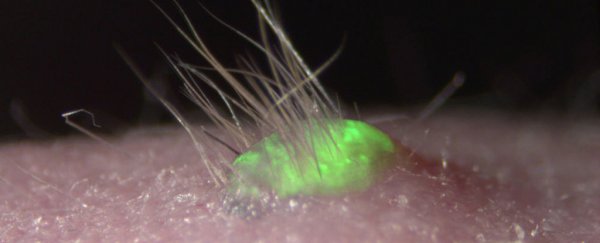The idea of growing human skin and artificial tissue in a lab might sound freaky at first, but scientists are hopeful that it could one day remove the need for transplants and enable us to patch up our own bodies like replacing parts in a motor car.
And this latest artificial skin, developed by researchers in Japan, is so realistic, it's able to grow new hairs and potentially even excrete sweat.
Led by researchers from the RIKEN Centre for Developmental Biology, the team extracted cells from the gums of mice and converted them into a specialised type of stem cell. They then used these to build three-dimensional skin-like structures - complete with functioning hair follicles and sweat glands.
Once transplanted back onto the skin of living, hairless mice, the new skin cells started developing normally. All three major layers of skin - the epidermis, dermis and subcutaneous layer of fat - were replicated successfully, and the artificial skin even made natural connections with the surrounding muscle nerves and fibres.
Those natural connections are the main reason hair was able to grow through the new skin.
"Up until now, artificial skin development has been hampered by the fact that the skin lacked the important organs, such as hair follicles and exocrine glands, which allow the skin to play its important role in regulation," said Takashi Tsuji, who led the new study.
"With this new technique, we have successfully grown skin that replicates the function of normal tissue. We are coming ever closer to the dream of being able to recreate actual organs in the lab for transplantation, and also believe that tissue grown through this method could be used as an alternative to animal testing of chemicals."
Not only would artificial skin reduce the need for experiments on mice and rats in lab conditions, it could make a huge difference to the treatment of burn victims and others in need of skin grafts. But the team estimates that it could be around a decade before the first treatments could be available in a clinical setting.
One of the biggest drawbacks right now is the fact that the artificial skin can't make new nerve fibres - it can only connect to existing ones. And the new hair that grows from the transplanted skin doesn't always match the rest of the body, as some white-haired mice in the experiment had black hair sprouting from their skin.
But it's a significant step forward from previous types of artificial skin, which lack many of the skin's natural biological components.
The team's findings have been published in the journal Science Advances.
